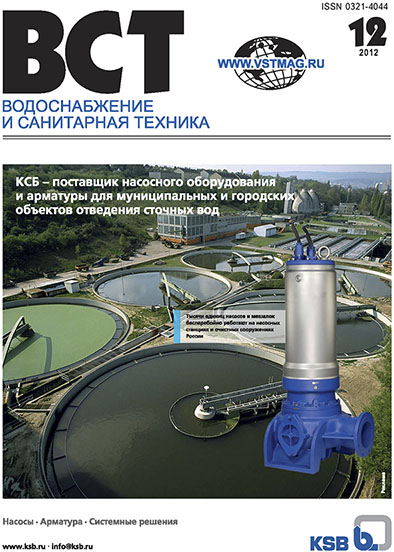
Number 12 / 2012
To download all number in format PDF (in Russian)The further text is accessible on a paid subscription.
For authorisation enter the login/password.
Or subscribe
Number maintenance (pdf) (doc)
Number abstract (doc)
Literature lists to articles (doc)
Index of the Articles (doc, pdf), Published in the Water Supply and Sanitary Technique Magazine in 2012.
|
bbk 000000
UDC
IIIrd «Pure Water» International Forum
|
bbk 000000
UDC
IVth IWA Eastern European Young and Senior Water Professionals Conference «Experience and youth in solving water problems»
|
bbk 000000
UDC
Federal Law «On water supply and wastewater disposal»: review, amendments and addenda
|
bbk 000000
UDC 628.113.8:504.064.2
Boronina L. V., Sadchikov P. N.
The appraisal of surface water sources quality
Summary
The results of the statistical appraisal of the parameters indicating the growth of vast majority of pollutants in the total volume of water samples are presented. Herewith the absolute values of the basic growth are positive, which is the evidence of the pollution buildup compared to 2006. The positive values of chain growth indicate unfavorable dynamics of the gradual increase of the given substances in weight; whereas the relevant comparative values (basic and chain increase and growth rates) show their percentage build-up.
Key words
treatment facilities , suspended substances , chromaticity , odor , pollutant , water sample
|
bbk 000000
UDC 627.8.62-192
KURANOV N. P., ROZANOV N. N., TIMOFEEVA E. A., Voinitch-Syanozhentsky T. G.
Estimating the safety and failure risk of hydraulic engineering structures
Summary
The need for improving the technique of estimating the failure risk of hydraulic engineering structures on the basis of the general concept of risk as the product of failure risk (frequency) by potential damage (social, material, environmental etc.) is substantiated. The results of investigations are presented that provide for the comprehensive estimation of hydraulic engineering structure failure risk levels. The suggested design approach is compared with the traditional method by test examples of estimating the risk of hydraulic engineering structure failure.
Key words
negative effect level , safety of hydraulic engineering structures , failure risk , hazard and vulnerability factor
|
bbk 000000
UDC 628.162:620.3
Kofman V. Ya.
Nanoparticles of metallic iron for ground water treatment (review of foreign publications)
Summary
The international experience in using the technology of ground water treatment with the help of nanoparticles of metallic iron is presented. The technology of injecting nanoparticles provides for their transfer through intake wells practically to any point at any depth of the ground water basin. Limitations are imposed exclusively by economic factors. The well number and placing are determined by geologic and geochemical characteristics of the polluted area subject to investigation. Prior to the implementation of a project studies shall be carried out to specify the required composition and concentration of iron particle suspension, injection equipment, well placing and depth, working pressure and consumption of the suspended matter, duration of treatment.
Key words
ground water , pollutants , injection , well , nanoparticles of metallic iron
|
bbk 000000
UDC 628.1/.2.001.2
Pupyrev E. I.
Selecting the technology of water treatment in the present-day economic environment
Summary
A formal approach to the evaluation of water treatment technologies that provides for comparing quality parameters, costs, reliability and availability indices is suggested. It is shown that one and the same technology being preferable at one settlement, however, is unpractical for applying somewhere else. It depends on the local economic environment, water quality, reliability requirements etc. It is possible to select the best technology for any settlement basing on local conditions. For design people the formal approach to the evaluation of the selected technology can be simplified, particularly for the cost–quality or quality–reliability ratios.
Key words
reliability , water treatment technology , quality , cost , availability
|
bbk 000000
UDC 628.292.65.011.4
Ignatchik S. Iu.
Energy conservation and reliability assurance in upgrading sewage pumping stations
Summary
The main principles of reliability and energy conservation calculation method for designing the upgrade of local sewage pumping stations that are transferring wastewater to the treatment facilities are presented. When preparing a feasibility study of the project design the technology and probability indices of reliability for each element of the process part of the pumping station together with probabilistic and individual dimension reliability are determined. The option of upgrading the process part is selected with account of the environmental requirements and investment efficiency of the project.
Key words
wastewater , power saving , operation expenditures , pumping station , calculated hydraulic model , net discounted expense , reliability indices
|
bbk 000000
UDC 628.336.5.004.18
Rublevskaya O. N., Melnik E. A.
Tackling the problem of energy saving in the Saint-Petersburg wastewater system
Summary
The technologies of primary and secondary sludge treatment at the Saint-Petersburg wastewater treatment facilities are considered. The technologies of thermal hydrolysis and thermophilic and mesophilic digestion were suggested by European companies PWT (Germany), Veolia (OTV, France) and Cambi (Norway). Implementing the project of using the energy potential of wastewater sludge will allow Saint-Petersburg Vodokanal PUE to gain unique experience of systematic approach to the solution of sludge utilization problem.
Key words
sludge , fermentation , biogas , methane tank , mesophilic process , thermophilic process , thermal hydrolysis
|
|